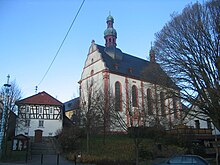Assumption of Mary (Spabrücken)
The Catholic parish and pilgrimage church of the Assumption of the Virgin Mary is a listed church building in Spabrücken in the Bad Kreuznach district . The church is part of a monastery that is currently used by the Catholic community of Sisters of Life .
History and architecture
Before the 11th century, the community belonged to the parish in Wallhausen. One church was mentioned in a document from 1338. The Capella in Spachbrücken was given a donation to the Laurentius Altar by a knight Udo and his wife Agnes.
The foundation stone of the previous churches is known to have been laid in 1359, a source reported: 1359. A beautiful church was built on the 17th of October . According to tradition from the 17th century, the church was under the patronage of the Blessed Virgin Mary. It was also consecrated to St. Lawrence and the Three Kings . Presumably Laurentius was the patron saint of the first church. The church was granted its own baptismal right in 1483, so it became a parish church. The congregation became Lutheran in 1560 and taken over by the Franciscans of the Cologne Order of Colonia in 1680 . The monastery was handed over by the treasurers of Worms, Barons zu Dalberg. During the Reformation, the tradition of pilgrimages was probably lost. It increased again in the 17th century. The first pilgrimage took place in 1681. The church was built by the Franciscans between 1731 and 1736, it stands on the foundations of the previous building. They also built a three-winged monastery complex from 1721 to 1736 . The church building is a single-nave hall church with a 3/8 choir closure and a sacristy to the east and has five star-vaulted yokes. Between the niches of the vaults, cartouches painted by Brother Angelus Homburg depict scenes from the life of Mary. On the mighty gable roof sit a two- and a three-storey roof turret that looks Gothic. The gallery, the former monks' choir, stands on the west side, it rests on pillars with Bohemian caps. Illusionistic paintings can be seen throughout the church. The building is 36 meters long, 14 meters high and 10 meters high, the tower is 41 meters high. In the past, a generous flight of stairs led from the baroque main portal to the foot of the church hill. The building was extensively restored from 2004 to 2007.
Furnishing
- Seated Madonna and Child, 14th century
- Canopy altar, 18th century
- 2 side altars, 18th century
- Pulpit , 18th century
- Organ, 18th century
- Communion bench and confessionals, 18th century
- Torso of a late Gothic stone figure, around 1390
- Parish archive with rich holdings from the 16th and 17th centuries
organ
The organ was built by Johann Michael Stumm around 1739 , it has 25 stops on 2 manuals and a pedal . After extensive reconstruction by Johann Stockhausen in 1896, the organ was restored by the Oberlinger company in 1988 and reconstructed based on Stumm's models. Approx. 65% of the entire pipework still comes from Johann Michael Stumm . Another restoration of the pipework and thorough revision of the intonation in the style of the Stumm workshop took place in 2011/2012 by Orgelbau Raab-Plenz, Bad Kreuznach.
|
|
|
|||||||||||||||||||||||||||||||||||||||||||||||||||||||||||||||||||||||||||||||||||||||||||||||||||||||
- Coupling : II / I, I / P, II / P
Peal
The church has four bells . The original small bronze bell from the Baroque period consisted of three bells, one of which hung in the small roof turret. After delivery in World War I , three new bells were delivered by the Mabilon bell foundry in Saarburg in 1925 . They had the strike tone sequence c sharp ', d flat' and f ". Only the smallest of them, the" Guardian Angel "bell survived the wave of deliveries in World War II as well as the bombing raid on Spabrücken. After an interim solution in the form of an electric steel plate bell, a decision was made Then in 1962 he bought three bronze bells that were cast by the bell foundry Mark in Brockscheid . The bells were consecrated on April 7, 1963.
| No. | Surname | Casting year | Foundry, casting location | diameter | Dimensions | Chime |
|---|---|---|---|---|---|---|
| 1 | Maria | 1963 |
Eifeler bell foundry Mark Brockscheid |
950 mm | 500 kg | a 1 |
| 2 | Joseph | 780 mm | 300 kg | c 2 | ||
| 3 | Francis | 650 mm | 200 kg | d 2 | ||
| 4th | Guardian Angel | 1925 |
Johann Peter Hausen-Mabilon , Saarburg |
560 mm | 120 kg | f 2 |
swell
- Reclam's Art Guide Germany III, Monuments, Rhineland and Westphalia. 1975, ISBN 3-15-008401-6 .
- Church guide church and monastery Spabrücken, pilgrim church yesterday. today . tomorrow, chronicles 1483–1986. Raab-Druck, Bad Kreuznach 1986.
- Dehio Handbook Rhineland-Palatinate, Saarland. 2nd Edition. Deutscher Kunstverlag, Munich 1985.
- Andreas Keber: The silent organ of the pilgrimage church Spabrücken. In: Ars Organi . 61, 2013, pp. 147–153.
Web links
Individual evidence
- ↑ Pages of the community
- ↑ Patronage
- ↑ New building in the 18th century
- ↑ New beginning of the pilgrimage
- ↑ Roof turrets and gable roof
- ↑ [total length: 36 | Tower height: 41 | Inner height: 14 | Span ceiling / vault: 10 dimensions]
- ↑ Renovation in 2004
- ↑ Reclam's Art Guide Germany III, Monuments, Rhineland and Westphalia, 1975, ISBN 3-15-008401-6 , pages 677 and 678
- ↑ Silent organ
Coordinates: 49 ° 53 ′ 57.5 " N , 7 ° 42 ′ 43.5" E
